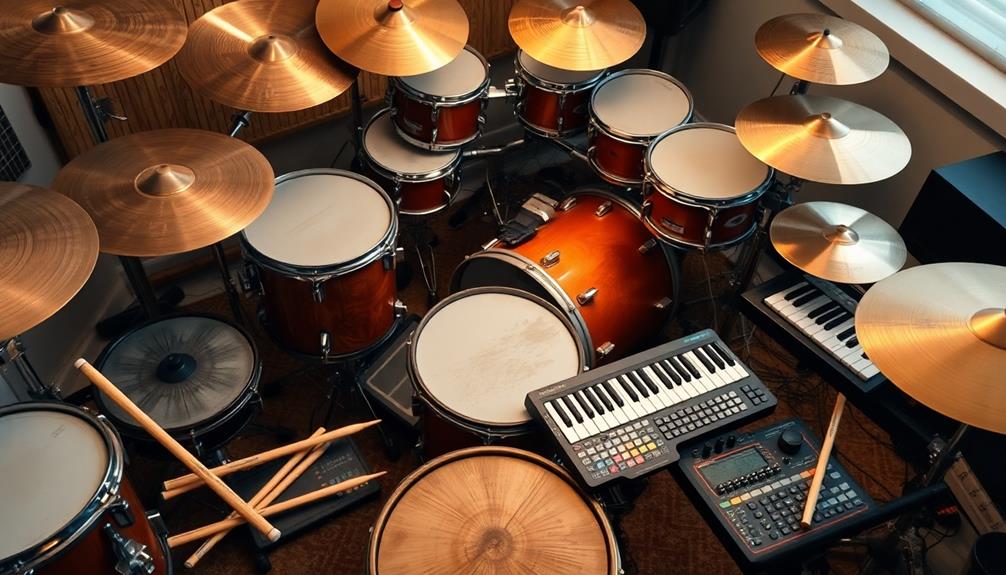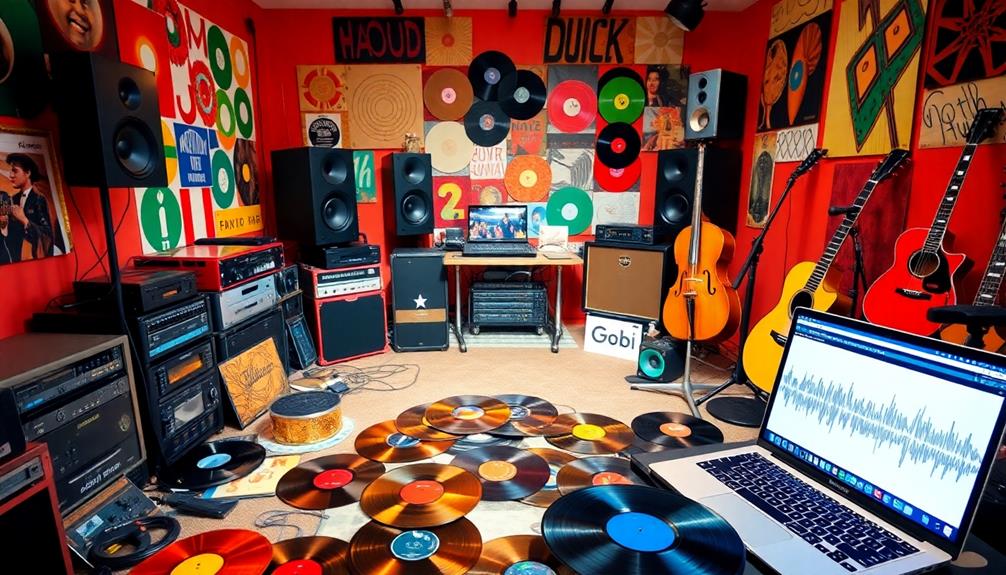To create natural sounding beats in drum programming, master techniques that mimic a live drummer's nuances. Start by layering different drum samples for richness and texture. Adjust hit velocities, especially on hi-hats, to add dynamic interest. Incorporate ghost notes at lower velocities to enhance groove without overpowering main beats. Timing adjustments can also help with a more organic feel; try moving notes slightly off the grid. Employ swing settings to create a relaxed vibe. These methods will elevate the authenticity of your rhythms, setting the stage for even greater musical expression as you explore further techniques.
Key Takeaways
- Adjust timing by slightly moving notes off the grid to create a more organic feel in your drum patterns.
- Vary hit velocities, especially on hi-hats, to add dynamic interest and authenticity to your beats.
- Incorporate ghost notes to add texture and depth without overpowering the main rhythm.
- Utilize swing templates in your DAW to enhance groove and create a relaxed feel in your drum patterns.
- Experiment with layering different drum samples to enrich the overall texture and sound of your beats.
Understanding Drum Patterns

When immersing yourself in drum programming, understanding drum patterns is fundamental for creating compelling rhythms. Different genres feature characteristic patterns that define their sound. For instance, rock typically highlights a strong snare backbeat, while hip-hop focuses on syncopation with kick and snare. Recognizing these distinctions will help you craft authentic beats that resonate with listeners.
The interplay between the kick, snare, and hi-hat is vital, as these elements shape the overall feel and drive of your drum track. Experiment with various drum patterns to find what fits best for your genre. Utilizing swing templates can also emulate a live performance feel, particularly enhancing the rhythmic quality in funk and jazz.
Incorporating ghost notes at lower velocities adds texture and depth to your patterns without overpowering the primary beats. These subtle percussion sounds can greatly enrich your drum programming, giving it a more dynamic presence.
Humanizing Your Beats

To create beats that feel alive, you need to humanize your programming. Start by making slight timing adjustments; moving some notes off the grid mimics the natural fluctuations of a human drummer. This helps your beats feel more organic and less mechanical.
Next, focus on the velocity of hits. Varying the intensity, especially on hi-hats, adds dynamic interest and keeps your track engaging. Most DAWs come with manual velocity adjustment tools, so take advantage of these to fine-tune each hit for a more authentic feel.
Incorporating ghost notes is another effective technique. These subtle, softer hits can enrich the groove while adding depth without overshadowing the main rhythm. They create a more complex texture, enhancing the overall vibe of your track.
Implementing Swing and Groove

When you want to bring life to your drum patterns, using swing templates in your DAW can make a huge difference.
By making subtle timing adjustments and experimenting with built-in groove templates, you'll find the right feel that resonates with your track.
Don't forget to tweak hi-hat velocities alongside these settings for an even more dynamic rhythm!
Swing Template Utilization
Incorporating swing templates into your drum programming can instantly breathe life into your tracks. By delaying specific beats, swing templates create a relaxed, organic feel that mimics live drumming.
Here are some tips to make the most of swing in your drum patterns:
- Start Small: Apply a swing percentage between 8-16% to enhance rhythmic quality without overwhelming the track.
- Experiment: Test different swing settings to see how they transform your straightforward drum patterns into engaging grooves.
- Balance Timing: Verify that your timing adjustments maintain the overall integrity and tempo of the track, avoiding a disjointed feel.
- Use Built-in Tools: Take advantage of groove templates available in DAWs like Ableton Live 12 to easily apply swing to your beats.
Groove Templates in DAWs
Groove templates in digital audio workstations (DAWs) can transform your drum programming by adding a layer of depth and expressiveness to your rhythms. Many DAWs, like Ableton Live 12, come with built-in groove templates that you can apply directly to your MIDI tracks. This feature helps create more humanized and organic-feeling drum patterns.
Utilizing swing settings is essential for achieving that live performance vibe. A slight swing adjustment (typically between 5-15%) can greatly enhance the rhythmic quality of your drum patterns. This small tweak can make your beats feel more dynamic without compromising the integrity of the overall track.
Here's a quick overview of how different settings affect your rhythms:
| Groove Template | Swing Setting | Effect on Drum Pattern |
|---|---|---|
| Default | 0% | Straight, rigid rhythms |
| Funk | 10% | Adds a laid-back feel |
| Jazz | 15% | Creates a syncopated vibe |
| Latin | 7% | Enhances rhythmic variations |
Experimenting with various groove percentages and note lengths can lead to unique rhythmic variations, encouraging your creativity while producing engaging sounds.
Subtle Timing Adjustments
Subtle timing adjustments can dramatically enhance your drum programming, giving it a more lifelike quality. By implementing swing and groove, you can create a more relaxed and human feel in your rhythms.
Here are some key techniques to take into account:
- Apply Swing: Delay certain off-beats slightly, typically in the range of 50-70% of the quantized value. This creates a laid-back vibe, perfect for funk and jazz.
- Vary Hi-Hat Sound: Shift hi-hat notes slightly ahead or behind the grid to mimic natural drumming variations, adding a dynamic quality to your beat.
- Experiment with Note Lengths: Adjusting the lengths of your notes can create unique rhythmic patterns that evoke an organic sound.
- Use DAW Groove Templates: Many DAWs, like Ableton Live, have built-in groove templates that make it easy to apply swing to your MIDI patterns.
Using Layering Techniques
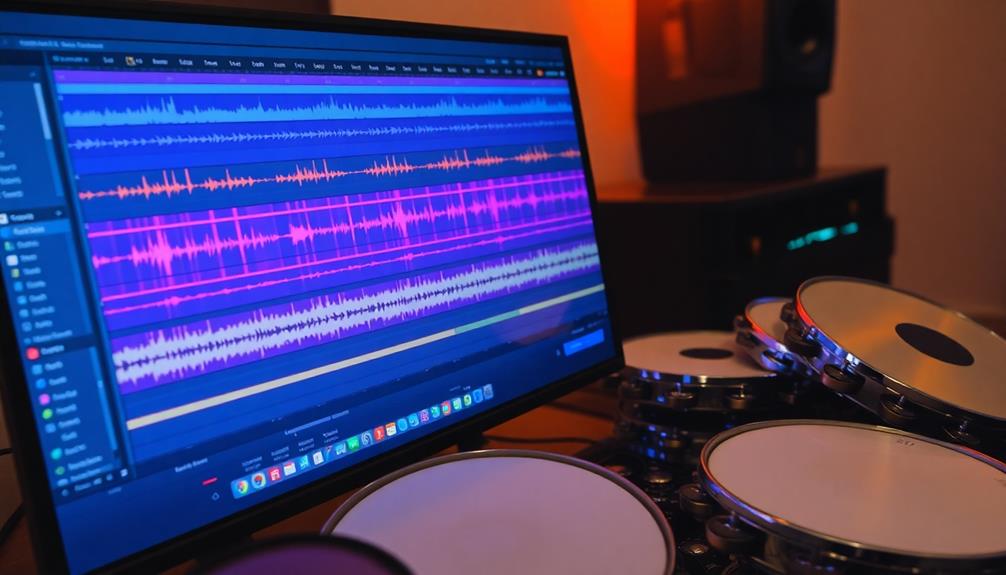
Layering techniques can take your drum programming to the next level, creating a fuller and more engaging sound in your tracks. One effective method is layering different drum samples, like combining multiple snare sounds. This approach enhances the richness and dynamic texture of your beats.
However, it's essential to adjust the volume levels of each sample to guarantee they blend cohesively without overpowering one another in the mix.
Don't shy away from utilizing unique layered sounds, such as adding subtle percussion or electronic elements. This can set your tracks apart, introducing fresh sonic characteristics that capture listeners' attention.
Experimenting with various drum kits allows you to find the perfect combination that fits your genre and style.
Additionally, consider employing subtle layering techniques. While ghost notes can add depth, focusing on the nuances of how each layer interacts can enhance the groove and complexity of your drum patterns.
Incorporating Ghost Notes
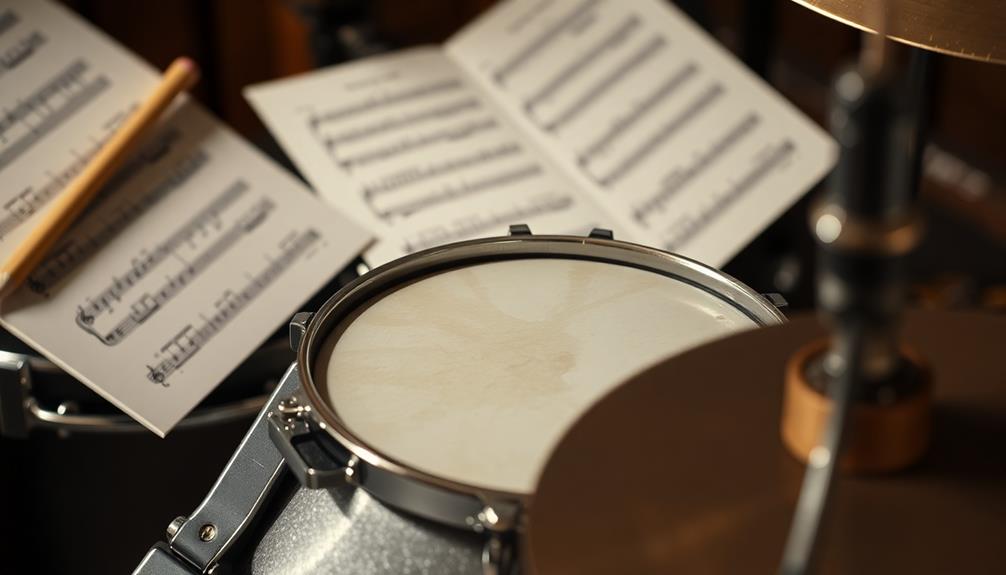
Incorporating ghost notes can really enhance the dynamics of your groove.
By adding subtle rhythm textures between your main beats, you create a more intricate and engaging feel.
Experimenting with their placement and velocity will help you find the perfect balance for your track.
Enhancing Groove Dynamics
While you might think that a strong drum pattern relies solely on the main beats, adding ghost notes can transform your groove dynamics dramatically.
Ghost notes are subtle, low-velocity hits that add texture and depth to your drum track, enhancing the overall groove without overpowering the primary rhythm.
Here are some tips to effectively incorporate ghost notes into your programmed drums:
- Placement: Focus on snare and hi-hat for ghost notes, as they can enrich the dynamic complexity of your patterns.
- Velocity Variation: Program ghost notes with varying velocities to mimic the nuanced dynamics of live drumming, creating a more organic feel.
- Experiment with Toms: Move ghost notes around different drum elements, like toms or rimshots, to introduce variation and keep listeners engaged.
- Layering: Use ghost notes to layer textures, adding more depth and intricacy to your rhythmic structure.
Subtle Rhythm Textures
Revealing the potential of subtle rhythm textures can elevate your drum programming to new heights. One key technique to achieve this is incorporating ghost notes—those low-velocity hits that enhance your drum sounds without overpowering the main beats. This approach is especially effective in genres like funk and jazz, where groove is essential.
To maximize the impact of ghost notes, consider their placement and velocity. Programming them at around 30-50% of your main hit velocity guarantees they add texture while remaining discreet. Varying their location across different drum elements, such as snares and toms, introduces unexpected rhythmic variations that keep listeners engaged.
Here's a quick reference table to guide you in using ghost notes effectively:
| Element | Suggested Velocity % |
|---|---|
| Snare | 30-40% |
| Tom | 40-50% |
| Hi-Hat | 20-30% |
| Kick Drum | 30-50% |
| Rim Shot | 25-35% |
Incorporating these subtle rhythm textures not only adds depth but also mimics the expressiveness of a live drummer's performance.
Building Energy for Drops

To effectively build energy for drops, you need to create anticipation in the two bars leading up to the moment. This is where you can really engage your listeners and elevate the tension in your track.
Here are some strategies you can use:
- Rising Effects: Incorporate white noise sweeps or rising synths to create a sense of urgency.
- Strategic Silence: Reduce or even silence drum hits before the drop to amplify the impact of the beat when it returns.
- Layering Different Sounds: Instead of just doubling your kick or snare frequency, build upon various musical elements and layers to create a more dynamic build-up.
- Anti-Drop Techniques: Implement unexpected rhythmic changes or pauses to enhance listener engagement and create memorable moments.
Tools for Effective Programming
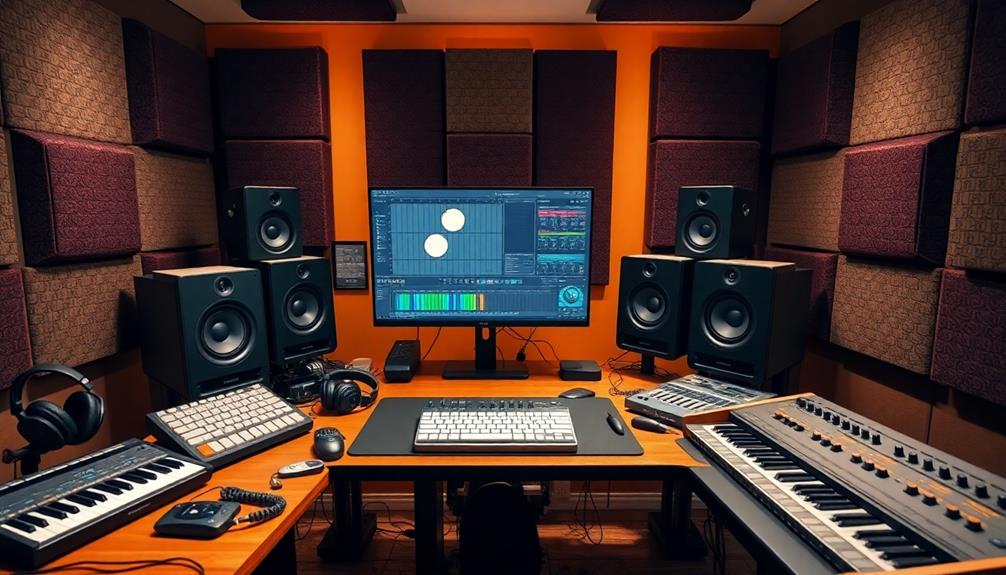
After building energy for drops, it's time to focus on the tools that can help you program your drums effectively. One essential tool is your DAW, where you can utilize MIDI libraries like those in Superior Drummer 3. These libraries offer genre-specific drum loops that elevate the authenticity of your beats.
Don't overlook velocity adjustments; experimenting with these within your DAW can create dynamic interest, making your programming feel more natural. Incorporating ghost notes at lower velocities adds subtle complexity without overshadowing the primary beat, enriching your rhythm considerably.
You can also enhance the groove by leveraging swing settings in your DAW. This humanizes your beats, especially in genres like funk and jazz, giving them that live performance feel.
Frequently Asked Questions
How Do You Make Drums Sound Natural?
To make drums sound natural, you'll want to vary hit velocities, add ghost notes for texture, slightly adjust timing, use swing settings, and layer diverse samples. These techniques create a more organic and engaging rhythm.
How to Program Drums That Sound Real?
Programming drums that sound real is like crafting a masterpiece. You'll want to vary timing, incorporate ghost notes, and layer samples. Embrace subtle imperfections to capture the essence of a live performance, making your beats truly dynamic.
How to Program a Drum Beat?
To program a drum beat, start with a solid pattern. Layer sounds, adjust velocities, and add ghost notes for depth. Experiment with swing to create groove. Balance your mix for clarity, and have fun exploring!
How Can I Make My Sampled Drums Sound Better?
Imagine a canvas where your sampled drums dance. Layer them like colors, adjusting velocities to create rhythm's heartbeat. Add ghost notes and microtiming, letting spontaneity breathe life, while swing settings bring vibrant energy to your creation.
Conclusion
By applying these tips, you'll find your drum programming takes on a whole new life. Remember, the magic often happens in the small details—like a ghost note sneaking in just when you least expect it. As you layer sounds and play with swing, you'll notice your beats not only feel more natural but also resonate with your listeners. So grab your kit, trust your instincts, and watch how your creativity unfolds in ways you never imagined!

